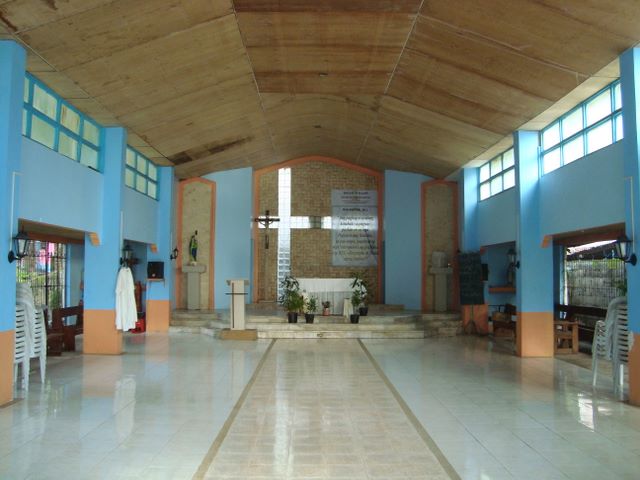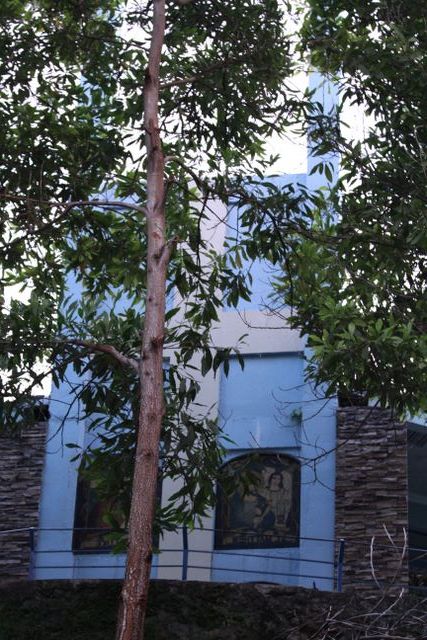 |
| The Magellan Shrine in Limasawa. |
Part of the Philippine Church History class of the Theo 3 of the St. John the Evangelist School of Theology was the discussion whether the first mass was truly celebrated in the island of Limasawa or in Mazaua in Butuan, as some would like to argue. So where would be the best place to have the debate than in Limasawa itself. I was invited by the class to join them with their teacher, Fr. Aaron, as they knew that I love going to the beach. Been to the place about fifteen years before, but I failed to bring along a camera so I had no souvenir shots then. Hence, I had no hesitation when I was invited to come. Since the car of the Rector was unavailable I had to provide them with the ride. I invited also my dive buddy, Ronnie Ramirez to come along as I knew he has not been to Limasawa yet. In a short notice he got the nod of his wife to come along and so not only did the class completed their transport, as I told Ronnie to bring along his car, but we also had a very good photographer in tow, he now being an avid photographer.
There are only two public boat transport that go to Limasawa daily. One of the boats is owned by the Diocese of Maasin which was made to help the parish priest in Limasawa and which they later converted as a passenger boat. Both boats would depart at one o’clock in the afternoon daily from Padre Burgos, S. Leyte. From Limasawa, the boats would depart at 6:45 in the morning for Padre Burgos. On that day that we went there, a special trip was made by the M/B Asuncion de Limasawa, the boat owned by the diocese, as yearly students from the Catholic school in Maasin would make a pilgrimage to Limasawa. Hence, instead at one o’clock the boat departed by three in the afternoon as they made two trips that day for the students. The ride going to Limasawa in certain times of the year can become very rough. During the “habagat” season the sea could be so treacherous that there could be weeks when boats could not go out at sea. The parish priest there, Fr. Ronald Lago who has been there for already eight years said that there was a time that he was stranded in the island for several months. Food supply ran out that they were almost starving. Rice does not grow in the island. They just had to make do with the root crops that were still available.
Limasawa has a population of 5,200 and is composed of six barrios : Cabulihan, Lugsongan, Magallanes, San Agustin, San Bernardo and Triana. The main poblacion is found in Triana which is on the western part of the island. The shrine where Magellan and his crew had the first mass in the Philipppines is on the eastern part now called Magallanes. Aside from the shrine there is also a commemorative cross planted by Magellan at the highest point of the island just above the shrine. There are 450 steps going there. Just near the shrine is a new Catholic church built. At the back of the church is a pad for the priest. Although the parish priest was told by the bishop to stay in this church, he preferred to live in Triana as this place is quite far from the neighbors. He, already living on a small island said would die of loneliness and silence if he still would reside here on a desolate hill. So he would just sleep overnight there from time to time.
Although the Catholics are the majority, they only compose 36 percent of the total population. The rest of the Limasawans belong to 13 other religions, the Filipinista (Aglipayans) as they are popularly known there comes in second with their church just beside the Catholic church in Triana. The people mostly depend on fishing for their livelihood. There are some good snorkeling areas and dive sites in the island. But because of the roughness of the sea for most times of the year, tourism on the island may not so much develop. There are no pension houses yet on the island for tourists. I did not hear about homestays if they are available.
Pictures with watermarks are by Ronnie Ramirez and others as cited.
 |
| An OSF sister assigned at the seminary came with us. She was the cousin of the parish priest of Limasawa. |
 |
| Fr. Aaron with the seminarians on board the motorboat. |
 |
| The name of the bishop of Maasin prominently displayed on the side of the boat. |
 |
| Photo by Ronnie |
The rocky landscape of Limasawa with the lighthouse on top. Photo by Ronnie.
There were here and there good white sandy beaches around the island.
Coconut trees cover most of the island Photo by Ronnie
The port in Triana, but no big boats have ever docked.
 |
| People were carrying their boats to the sea ready for a night of fishing as we arrived. |
The other public motor boat plying the seas between Limasawa and Padre Burgos
The flying fishes were the only catch that day.
A solar powered water tank.
The main street in Triana
The Catholic Parish Church of Limasawa
Inside the Church of Limasawa
The Philippine Independent Church (Filipinista or Aglipayan Church)
The Catholic church and the Aglipayan church are just besides each other.
The Magellan shrine situated in the eastern part of the island of Limasawa. The barrio is now called Magallanes.
The historical marker of the First Mass in the Philippines.
The church in Magallanes which is just near the shrine.
450 steps leading to the cross planted by Magellan. It overlooks the whole island and from there one has a good view of the mainland of Leyte and Surigao.
The Magellan cross.
With a wide expanse up on the hill, the seminarians had a heyday "flying" on a pole. This is facing the east towards mainland Leyte.
We could not resist but join the fun.
The sunset in Limasawa was a beautiful setting for the continued "flight into the night."
Sunset in Limasawa.
The white sand in Triana, just in front of the church.
 |
| The elementary school is also beside the church. |
We had to walk through rocky paths to get to the Marine Sanctuary area of San Agustin which was a good site for snorkeling. There are also good dive spots in Limasawa. Dive shops are found in Padre Burgos.
Photo by Ronnie
Some of the corals in San Agustin marine sanctuary. There was a good area where corals where found but my camera did not function well that day. Pictures came out blurred.







































